
The Spelling Bee Puzzle
of
The New York Times

Here is the NY Times version:
There are several videos to show how it works.
Give it a try and what you think.
My name is Jon Bjornstad. I live in Davis, CA. I am 74 years old. I retired from the corporate software world a few years ago but I still very much enjoy the art of programming. In short, I am an old Perl hacker. When I saw the Hint Table of the NYT Spelling Bee and realized that it was static, that it did not change as you found words, I immediately thought, “That’s not right. I can do better.” And I have. The complete source code for this project is on github.
| Basic Operation | 7:47 |
| Hints | 13:13 |
| The NYT Archive | 6:51 |
| Clues | 11:14 |
| Creating a Community Puzzle | 16:41 |
| Tips & Tricks, Bits & Bobs | 7:46 |
| 1:03:32 |

Finding all of the words is just one way to play. There are other 'games within the game' that are another kind of fun challenge.
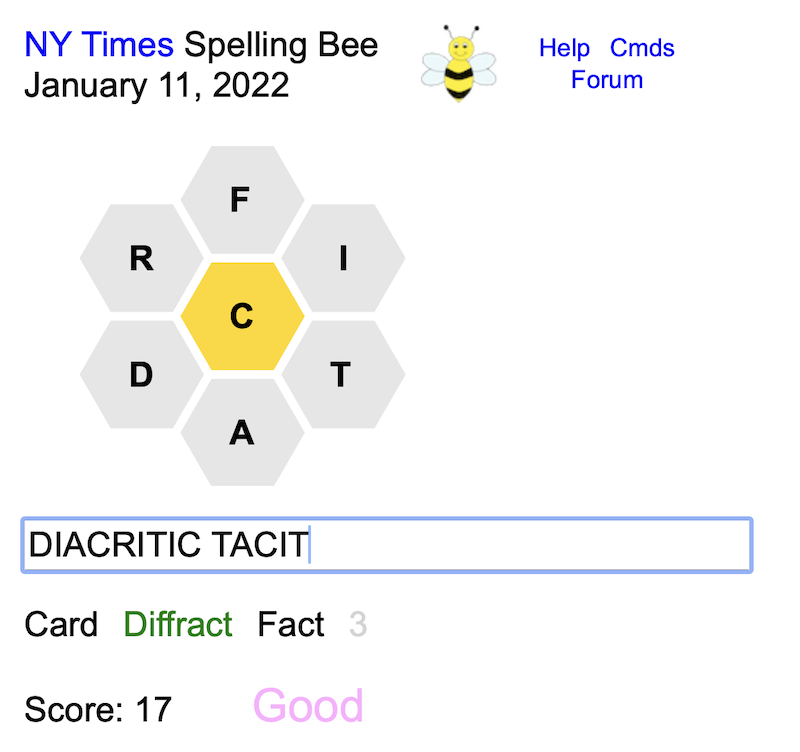
In the text field you enter words that satisfy the rules of the puzzle. You can enter more than one word. Press Return to see if the words are acceptable. Any error messages will appear above the text field. Words you have found will appear below the text field in alphabetical order.
Pressing Return when the text field is empty will clear any messages. If there are no messages to clear, the 6 outer letters will be permuted.
If you lose focus on the text field you can restore it by hitting the Tab key.
At the top the Help link shows this document. The Cmds link shows the list of commands you can enter in the text field. Here are a few simple ones:
| I | Show Information about the puzzle including numbers of words, points, pangrams, and (maybe) Bingo.
Note that a pangram is termed “perfect” if it is 7 letters long.
If the puzzle was created by the community (instead of the NYT) details from the creator are given. If clues have been added for a puzzle the authors are listed. Click on an author name to see all of their clues. There are 6 different formats you can choose from. There is also the word “HiveMind” which is a link to the forum of the NY Times. Click on it to see the extended yet entertaining discussion about the puzzle. |
| R | Show the rankings - from Beginner to ... Amazing to Genius to Queen Bee. It also shows how many points are needed to get to the next rank. |
| W | Show the found words in the order they were found. |
| SC | Show how the score was tallied and how many words remain to be found. A thin line shows where you first asked for a hint. |
| TOP |
Show the screen names of people who have achieved
the ranks of Queen Bee down to Good Start for today's puzzle.
Also shown are the number of hints they needed.
If someone achieved GN4L or GOTN this is noted.
Bingo achievements are shown for
Bingo puzzles.
There is a link “Share your score.” Clicking on it will copy a description of your scores to the clipboard. You can paste it into a text message or email to share your score with your friends. It looks like this: Enhanced NYT Bee 09/22/2023 Bingo 7, 0 Hints Great 5 Hints 18 Bonus 6 BOA 13 Donut |
| ST | Toggle the showing of puzzle status: numeric or graphical. Default is numeric. The numeric status looks like this:
The graphical status looks like this:
b - bingo The bingo line will appear only if the puzzle is a Bingo. If the number of hints exceeds the number of words the line of dots will be truncated and a + will be appended. Note that words in the stash and perfect pangrams are shown differently:
This shows that there are 3 pangrams, 2 of them are perfect, 2 have been found, and one is in the stash. Another non-pangram word was also found giving a total of 3 found words, 2 of which are pangrams.
|
| C Y | Clear the puzzle and start over. C Y means Clear and confirm with Yes. |
The screen name is your unique public-facing name. The identity string is private, secret, and unique.
Screen names are shown with the CW command which shows the fun competition for Extra Words. They are also used when you post a message to the Forum.
You can change your screen name at any time with the command SN like so:
The screen name can be almost anything you wish. The only restriction is that it cannot contain the characters <, >, or space. Uniqueness is enforced. The name is entered in ALL CAPS but is transformed like so:
Entering the SN command by itself will show you what your screen name is.
This string is saved in your web browser data (aka cookies) so that if you leave and return later your words and games are remembered. Nice.
The unfortunate issue with this mechanism is that if you:
A better way to establish your identity is to create a string that you know is (very likely) unique to you (like your name plus your birthdate) and enter it with the ID command. For example:
Now if your web data and browser history is cleared or you use a different browser you can easily re-establish your identity by RE-entering the above command.
The ID command can be used if you mostly play on your computer with a keyboard but also want to play on your mobile phone when you are out and about. Enter your ID command in both places and you will see your words and games in both places. Nice!
Entering the ID command by itself will show you what your identity string is.
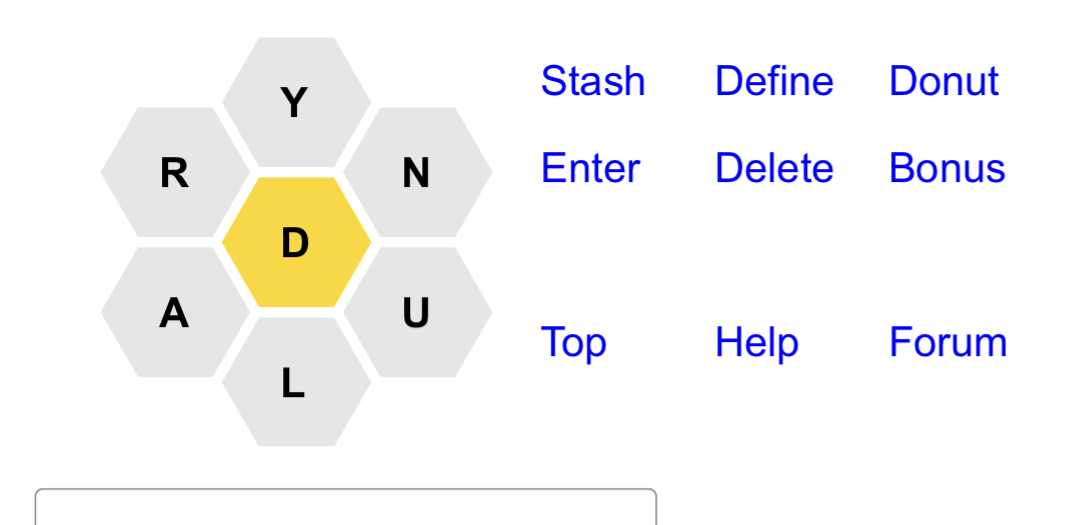
Android phones will behave in a similar way. If you are playing on an iPad or Tablet with a touch screen you can use the MO command to toggle into “mobile mode”.
In this mobile mode the heading has been toggled off. There are 9 command links to the right of the hexagon letters: Stash, Define, Donut, Enter, Delete, Bonus, Top, Help, and Forum.
Tapping on letters will copy them to the area on the right:
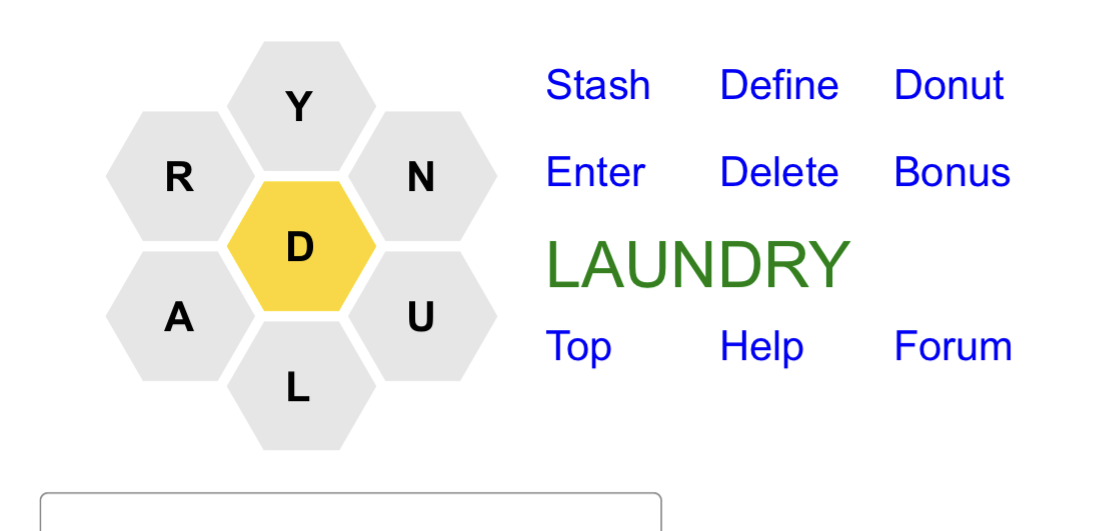
Tap on Stash to add the word to The Stash.
Tap on Define to do a DR command to define a random unfound word.
Tap on Donut to switch into Donut Mode.
Tap on Enter to submit the word.
Tap on Delete to remove letters.
Tap on Bonus to switch into Bonus Mode.
Tap on Top to issue the TOP command.
Tap on Help to bring up this document in a separate browser window.
Tap on Forum to toggle Forum Mode.
If you wish to enter a command, see the list of found words, or view the Hint Table simply scroll down.
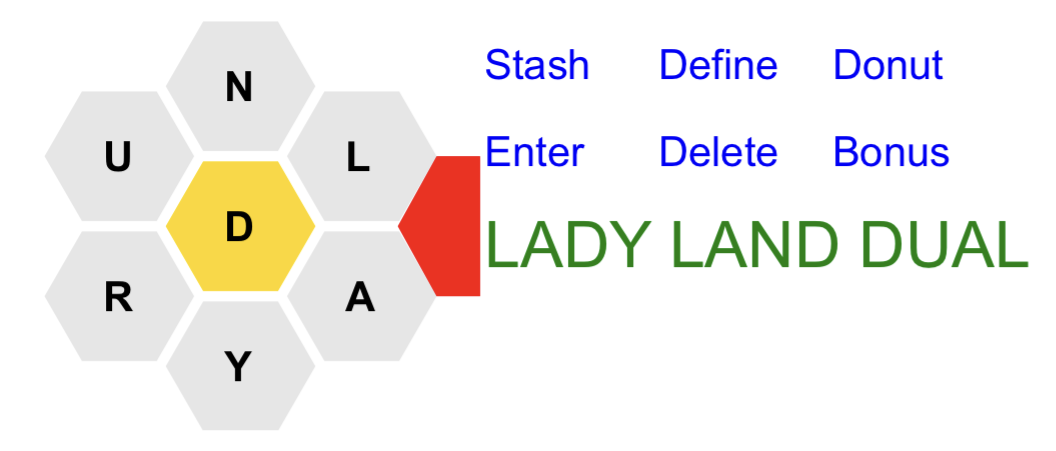
See the red pentagonal shape? It won’t be red on your screen but tapping on that area will insert a space character. This will enable you to enter multiple words before Entering them – as illustrated. When you have entered a lot of words the font will be reduced so you can enter even more words!
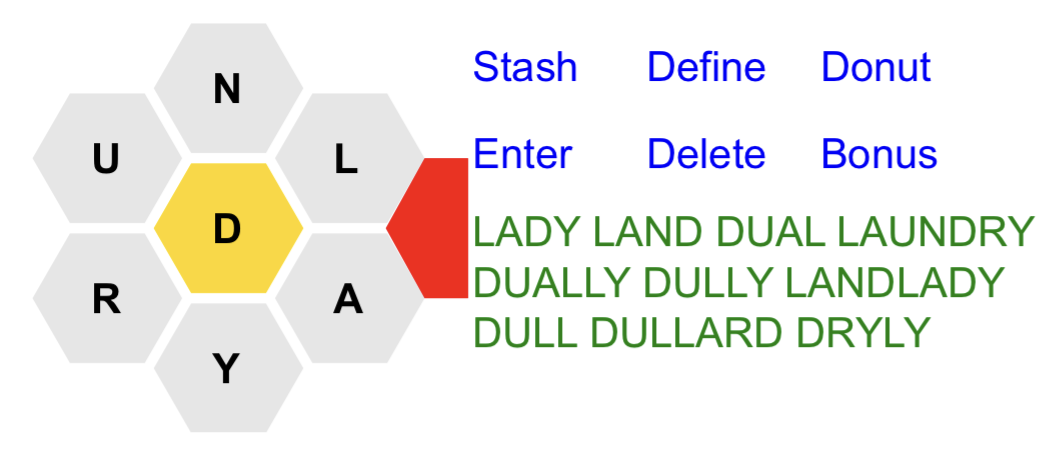
Just for fun, (and because this document is already TL;DR = “too long; didn’t read”) here is the previous paragraph rewritten by chatGPT in the style of a Rap/Hip-Hop artist and then in the style of Ralph Waldo Emerson:
It's like a key to unlock,
the multi-word flow,
Enter as many as you want,
before you hit go,
As shown, it's like a demo,
of what you can do,
Type away, and the font'll shrink,
so you can get it through,
You can enter all your thoughts,
without a single pause,
The font'll adjust,
so you can keep on applause,
So tap that shape,
and let the words start to flow,
You'll be typing like a pro,
in no time, yo!
Thus, the boundaries of expression are expanded, and the mind is free to roam, unencumbered by the constraints of the physical realm. The multitude of words, like a river’s tributaries, converge and flow into the vast ocean of thought, as illustrated by the sages of old.
And when the vessel of expression is filled to overflowing, the font, like a wise and benevolent guide, adjusts its proportions, that even more of the divine effluence may be contained, and the soul’s grandeur be revealed in all its majesty.
| HT | Show the Hint Table. |
| TL | Show the Two Letter List. |
| The Hint Table and the Two Letter List are explained below. | |
| 1 | Show a random entry from the Hint Table. |
| 2 | Show a random entry from the Two Letter List. |
| These two will work even if the full Table and List are not shown. | |
| Note: The Define and reVeal commands below will skip words that have already been found. | |
| Definitions/Clues | |
| DP | Define the Pangrams. |
| DB8 | Define the words beginning with B of length 8. |
| DGA | Define the words beginning with GA. |
| DR | Define a random word from the list of words not yet found. Note that if there are no 4 letter words in the found list the DR command will do a D5 to only include 5+ letter words. This will help when trying for GN4L. |
| D <word> Define the word.
You can ask for definitions of any word - not just the ones in the puzzle.
No hints are tallied.
This form of the D command serves as a quick and fun way to browse a dictionary that is more pleasant somehow (less clutter and noise!) than a full web site. You can give multiple words on the command line.
You can also type a word followed by D to get the definition:
| |
|
Definitions are from wordnik.com. These definitions are very brief because they’re just a hint. Complete definitions would cover multiple meanings and multiple parts of speech. Once a word is found and shown in the Found Word List you can click on it again to see the brief definition.†††
The command Q (or ?) will show the definition of the last word that was found.
Click on brief definitions to see the complete definition from wordnik.com in another window. And (a hidden feature) if you’d like to hear the word pronounced aloud click on the word at the top of the complete definition. For some reason, this works for root words but not derivations (e.g. change not changing). If there there is a clue for a word it is shown first followed by the dictionary definition. The power user command OC will toggle between seeing only the clues or seeing both the clues and the definitions. The default is to show both. | |
| Revealing Letters | |
| V2P | Reveal the first two letters (and the length) of the pangrams. |
| V3B8 | Reveal the first 3 letters of the words beginning with B of length 8. |
| V4GA | Reveal the first 4 letters (and the length) of the words beginning with GA. |
| Using E instead of V reveals letters at the front and at the End of the word. Commands that would reveal the entire word (like V4B4) are silently ignored (as are commands like V1B8 or V2GA). | |
The Hint Table (aka The Grid) (invoked with the HT command) looks like this:
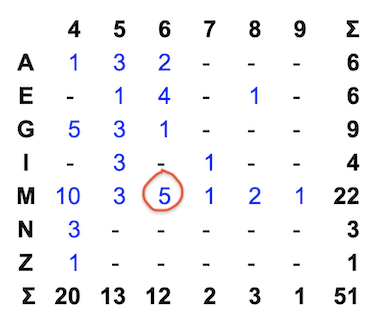
The Two Letter List (invoked with the TL command) looks like this:
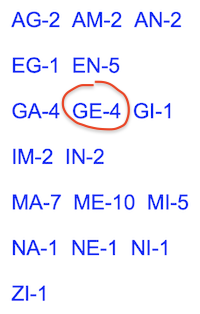
There are two important things about the table and list.
For those who work on the puzzle at nytimes.com or with the NYT mobile app and would like the Table and List to be dynamic there is a solution:
| Hint Command | # hints | |
|---|---|---|
| HT | 10 | |
| TL | 5 | |
| D | 3 | for each word |
| V,E | 2 | for each word |
| 1 | 1 | |
| 2 | 1 | |
| DR | 1 | |
| D5 | 1 | |
| 51 | 1 | |
| 52 | 1 | |
| #B, #4, #>4 | 1 | |
| # | 0 | |
| BT | 0 | |
| G Y | 5 | for each word |
The I (info) command shows the names of the people who provided clues. Clicking on a name will show all of their clues. This will not cost you any hint points at all and is one of many ways that you can “cheat”!
Note that with enough hints you can always make it to Queen Bee. For example, with the 5 letter word MAGMA you could ask for the hints V4MA and E2MA to get all 5 of the letters.
Once the rank of Amazing is reached the ratio of hints to total score is shown. Here’s an example of where I struggled to get to Queen Bee after I got to Genius 😥:
The command BT (Bingo Table) shows a subset of the Hint Table. For each of the 7 letters it shows the lengths of the words with minimum and maximum scores. This helps when you are aiming for level 4 Bingo. For example (from 1/22/21):
| C | E | I | N | O | T | V | |
|---|---|---|---|---|---|---|---|
| Min | 4 | 5 | 4 | 4 | 5 | 4 | 4 |
| Max | 10 | 8 | 12 | 8 | 5 | 8 | 6 |
| * | * | * |
BT does not tally any hint points.
As in the Hint Table the numbers in the BT table are links - to show a brief definition of the word(s). BT is a toggle - the default is off. If a puzzle is not a Bingo no table will be shown.
If you enjoy Bingo games there is the command NRB which will start a New Random Bingo puzzle from the NYT archive.
The TOP command shows Bingo achievement scores that are tallied like this:
| First 7 words | 1 |
| Alphabetical Order | 2 |
| Minimum Score | 4 |
| Maximum Score | 8 |
Even better and more convenient, after a Minimum Score Bingo the message will contain a link: "On to Max Bingo" which will do the 'SWA' for you. And after a Maximum Score Bingo the message will contain a link: "On to GN4L" which will stash any four letter words and unstash any 5+ letter words and ... turn off the Bingo Table.
Since 4 letter words are only valued at 1 point, attaining GN4L is almost always possible. In the first 1530 games in the archive there were only 8 games where GN4L was not possible. 10/8/19 is one example. If GN4L cannot be achieved this is noted in the output of the 'I' (info) command.
Even though it is almost always possible, getting to GN4L isn’t easy and here are a few commands to help:
| D5 | Define a random word not yet found that has 5 or more letters. Note that if you only have 5+ letter words in your found list the DR command will do much the same as the D5 command. |
| 51 | Show a random non-zero entry from the Hint Table where the length is 5 or more. |
| 52 | Show a random entry from the Two Letter List of words with a length of 5 or more. |
When you achieve GN4L you get a congratulatory message:
Two another Genius level variants are when you did not need a Pangram to reach Genius. The codes for these are: GN4L-NP and GOTN-NP. If GN4L-NP is not possible this is also noted in the I (info) command.
The PG command will tell you how many more points you need to reach the Genius level. If you are at or over Genius it reports how many more words you need to reach Queen Bee.
As you get close to Genius you can consult the Hint Table to see if there is a 5+ letter word remaining that will get you to Genius exactly. If not, you could stash a word with the SW command like this: SW <word>. This will adjust your score so you can then have other ways to make the score match the Genius level exactly.

More conveniently, the SW (or just an S) could be entered at the end, if you wish:
Note that words are checked before stashing. Only valid puzzle words are stashed. Extra words will be added as usual.
Note that if you see a Bonus or Donut word it’s okay to enter them whenever you wish. The C Y command will not clear them.
When you finish with minimal Bingo you likely want to go on to maximal Bingo (which is much harder) or GN4L. But you don’t want to forget the 4 letter words you entered! There is a command to help:
The words in the Stash are shown below the Donut, Lexicon, and Bonus words. Something like this:
There is a variant on the SA command:
Another (and likely easier) way to UNstash a word is to first click on it to get its definition. Above the definition there will be a link labeled 'UNstash'. Click on it do the unstashing.

For power users: In the command SA XX the XX is actually a Perl regular expression (with the /x flag) so with this in the stash:

Donut Words are deemed acceptable if they occur in the large lexicon †††† or have appeared before in an NYT Bee Puzzle OR if they have a definition at wordnik.com.
If you try to find Donut (or Lexicon) words by typing words that you don’t know
and suspect may be a valid word you may be pleasantly surprised
that it is indeed an acceptable word. For example:
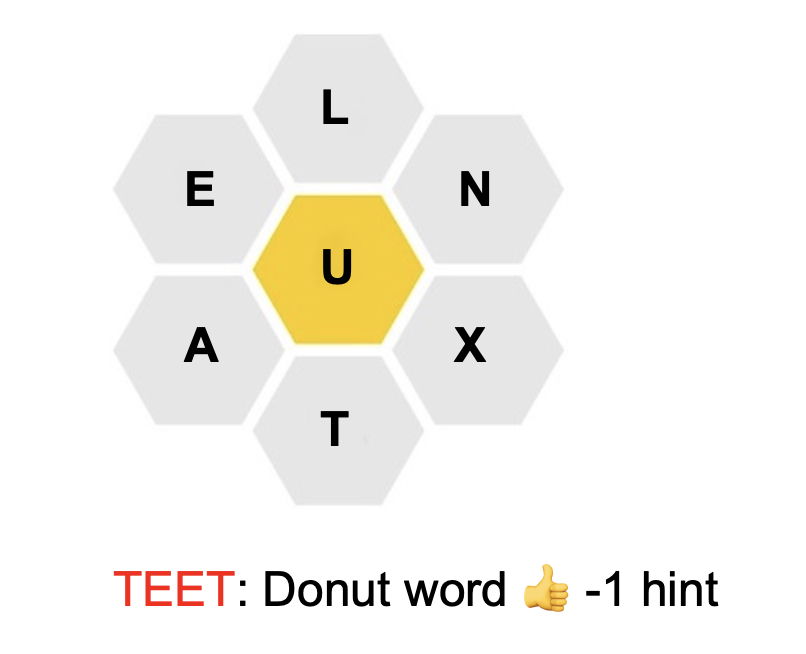
So now you are probably wondering what TEET means, right?
You can click on the red TEET
and a definition will be shown. Nice! Another way to see the definition
of the last word that was found is the Q (or ?) command.
To faciliate your search for Donut words you can toggle into “Donut Mode” with the command DN. This will only show Donut words you have found and the center letter will disappear because you won’t be using it. When you toggle the letter display with H to show the letters in a straight line the center letter will be omitted. Toggle out of Donut Mode with the command DN as well.
When playing on a mobile phone there are links to toggle into and out of Donut mode. In Donut mode the screen looks like this:
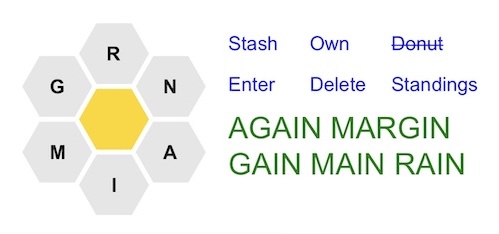
Note: The center hexagon will issue a space so you can enter multiple donut words at the same time. The center hexagon will briefly flash pink to indicate that the space was inserted.
When viewing the letters horizontally (with the H command) they will look like this:
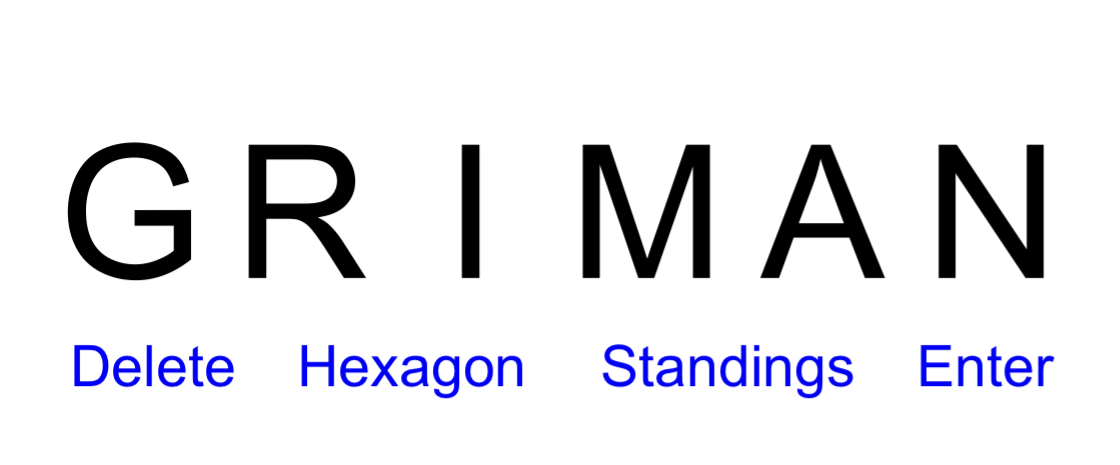

the words WAIN and WANG are such valid words that
were not included in the allowed list - because they are rare or obscure?
These disallowed words are the subject of many many repetitous and lengthy
discussions and debates in the HiveMind Forum. One example is
the word URTICARIA - see
the NYT HiveMind forum for May 16, 2022.
These words are called “Lexicon Words” because they are to be found
in the large lexicon.
In this puzzle from November 13, 2022:
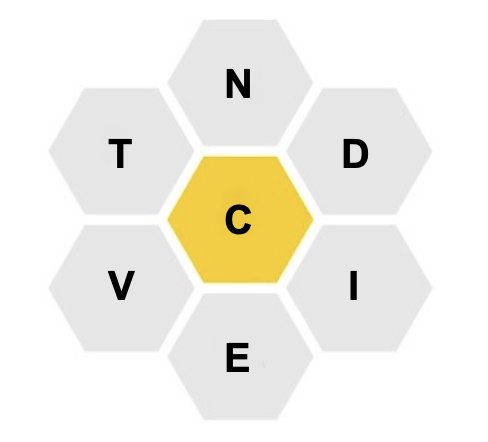
the words VICINITY and INCITEMENT are Bonus words which use an additional Y and M respectively. Bonus words must appear either in the large lexicon or in the list of previous NYT Puzzle words OR if they have a definition at wordnik.com. The additional letter can be an S (finally!). SCIENCE is another Bonus word for the above puzzle.
Note that very few plurals occur in the large lexicon and that many words ending in ING and ED are absent as well. wordnik.com does have definitions for most plurals. Since this would result in a plethora of Bonus words just by adding an S (or ES) to Donut words that are nouns (or verbs) these type of Bonus words are not allowed. Apologies for those who enjoy accumulating vast quantities of Bonus words. 😊
It seems that Bonus words are often more colorful and intriguing than the typical boring “normal” words.
Playing Spelling Bee hopefully expands our vocabulary. But … if you only play the standard puzzle your vocabulary is biased by words with <= 7 unique letters. AND no words with S or both E & R. 😜 Bonus words expand that a little.
On May 16, 2022 this was the NYT Puzzle:
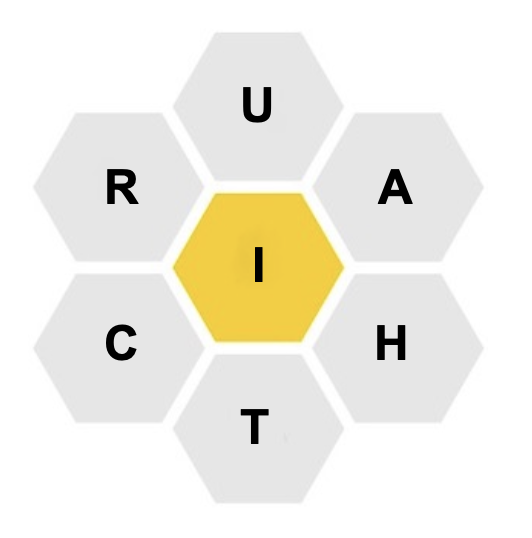
And here is a screenshot from the NYT Spelling Bee HiveMind Forum on that day:

This is evidence that Donut and Bonus words are a troublesome issue for those who only play on the NY Times site! On this site they are an added fun competitive challenge. 😊
A Bonus Pangram is one that uses all 7 letters plus the extra one. In the above puzzle ARCHITECTURE would be a Bonus Pangram. A Perfect Bonus Pangram is exactly 8 letters long. There is yet another type of Bonus Pangram – which I will leave undocumented so you can have the pleasure of discovering it on your own.
When searching for Bonus words this list of words from the large lexicon may help:

Note that the command C Y will clear puzzle words but leave the Extra words. C YA will clear all words.
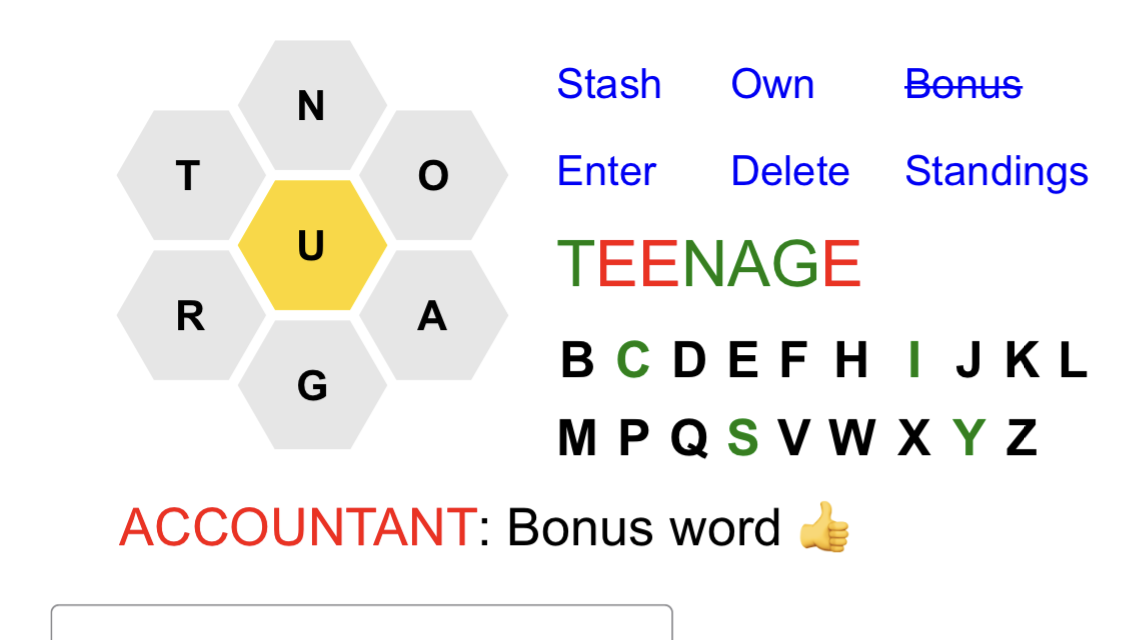
The 19 (26-7=19) additional letters are put in a table.
Tap on them to append to the word.
If a Bonus word has been found using a letter it will be green.
There are also command links for
Stash,
Own,
Bonus,
Enter,
Delete,
and
Standings.
When NOT on a mobile phone the BN command will put the 19 additional letters above the list of Bonus words.
Note that when in Bonus Mode only Bonus words are shown – no Puzzle, Donut or Lexicon words. And since you are not looking for puzzle words, the Status (numeric or graphical), Hint Table, and Two Letter List are hidden as well. This helps you focus on finding those elusive colorful intriguing Bonus words!
| DW | Show all Donut words in alphabetic order. |
|---|---|
| LW | Show all Lexicon words in alphabetic order. |
| BW | Show all Bonus words in alphabetic order. |
| NDW | Show all Donut words in order of how many different people found them. |
| NLW | Show all Lexicon words in order of how many different people found them. |
| NBW | Show all Bonus words in order of how many different people found them. |
| ABW | Show all Bonus words in order of the additional letter. Within that additional letter the sort is by the number of people who found the word and then alphabetically. At the end are tallies of the number of words containing the center letter and also by length. |
Note: These lists of words can change after the day of the puzzle. Furthermore, as a “very big cheat” you could select, copy, and paste all of the words into the text box to add to your collection.
| OW | This tells you which
Extra words were found Only By You. When an extra word is entered you are informed if it is an “Own” word.
|
|---|---|
| CW | Community Words.
The 'C' could also stand for Competitive 😊.
Show the screen names
of the 5 people who found the most
Extra words (Bonus, Donut, and Lexicon) for the current NYT puzzle.
For example:

CW 10 will show the top 10. Note that this command only shows the counts of words that were found on the day the puzzle was released. This command can be entered throughout the day of the puzzle. CW introduces a fun competitive drive to try to find more and more words. Note that CW also shows OW and BOA scores. |
| NR | New NYT puzzle from a Random date. |
| <date> | New NYT puzzle from the given date. You can enter dates in several ways: 10/20/19 or 9/23 (current year) or 15 (current month - but not 1 or 2 for the 1st or 2nd). Dates must be on or after May 9, 2018. |
| T | Return to today’s NYT puzzle. |
| Y | From today's puzzle move to yesterday’s NYT puzzle. If on another NYT puzzle date it will move to the day before. |
| -1, -7 | Move to yesterday’s puzzle (-1) or the puzzle from a week ago (-7). |
| L | List the current puzzles. * marks the current puzzle. p marks puzzles where all pangrams have been found. You can click on the puzzle date to switch to that puzzle. |
| N | Move to the next puzzle in the list - wrapping from last to first. |
| P | Move to the previous puzzle in the list - wrapping from first to last. |
| P<num> | Move to puzzle #num in the list. |
| X | Remove the current puzzle from the list and move to the first in the list - or today. This clears the words you found in the removed puzzle so if you choose the puzzle again you will start afresh. |
| X<nums> | Remove the numbered puzzles from the list. You can give a range. For example: X 2 4-6 9 |
| XA | Remove all puzzles from the list and return to today’s NYT puzzle. The words you found in today’s puzzle are preserved. |
| Community Puzzles | |
| LCP | List the 5 most recent Community Puzzles. LCP 10 will list 10 puzzles. LCP <pattern> will show the puzzles created by people whose names match the pattern. Click on the CP## to start solving the puzzle. |
| RCP | List community puzzles that I recommend because I find them interesting, clever, or an unusual challenge. |
| CP<num> | New Community Puzzle #num. This plays the puzzle. To create a puzzle click here. |
| YCP | List the Community Puzzles that you created. Click on the CP# to edit the puzzle. You can change the words, clues, title, and description. |
| XCP<num> | Delete Community Puzzle #num and revert to today’s NYT puzzle. You can only delete puzzles that you created. You would only do this if you deem the puzzle to be flawed in some way. |
If you enjoyed a puzzle and want to share it with a friend
you can click on the bee logo ![]() at the top.
This will take a link
to the puzzle and copy it to the system clipboard.
The link can then be pasted from the clipboard into a text message
or an email.
at the top.
This will take a link
to the puzzle and copy it to the system clipboard.
The link can then be pasted from the clipboard into a text message
or an email.
There is no guarantee that your accumulated puzzles will not be lost (inadvertently oops) or tidied up for you (to save disk space?). If you would like to keep a permanent record of the many puzzles you have played there is the command DL (for DownLoad). It will generate downloadable comma-separated files of your puzzles and display, for example:
Links to download your puzzle files:
List Full
The Full link will download a file with 11 columns: date, letters, center, rank, all pangrams, number of hints, puzzle, donut, lexicon, bonus, stash. The last 5 columns contain the words you found in each category. The words are space separated. This will give you everything that you could conceivably want, yes? 😊
The above 'date' column format is either yyyymmdd (for NYT puzzles) or CP### (for community puzzles).
The downloaded files have a .csv suffix and can be loaded into a spreadsheet. Spreadsheet wizards can adjust the column formatting to display the last 5 columns with narrower widths and wrapped text.
The DL command will not remove the puzzles. You can do that, if you wish, with the XA command, at your leisure.
This enhanced Bee has a discussion forum as well. It is built-in to the software which makes it easy to use. It is simple but sufficient. The command F toggles Forum Mode on and off. You can also toggle it with the Forum link in the heading. When it is on the screen looks like this:
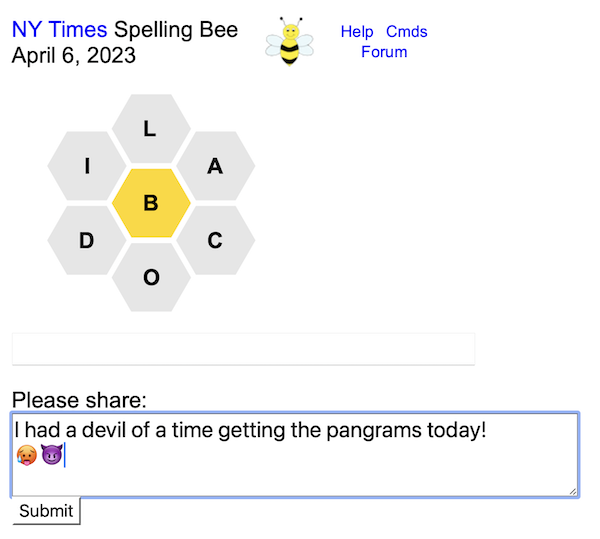
The word lists, status, and hint table are not shown. Instead, there is a text area where you can share your thoughts. When you have finished composing your message press the Submit button. Your message will appear below along with your screen name and the time. Messages are shown in reverse chronological order.

When composing your message:
 .
.

Messages are associated with the puzzle itself and persist. The forum is a good place to give praise and thanks to the creator of a Community Puzzle.
Remember that the F command is a toggle. After viewing the current messages and posting your own you can toggle back to the normal display. Even while you are in Forum Mode you can still enter commands and any new words that you have found.


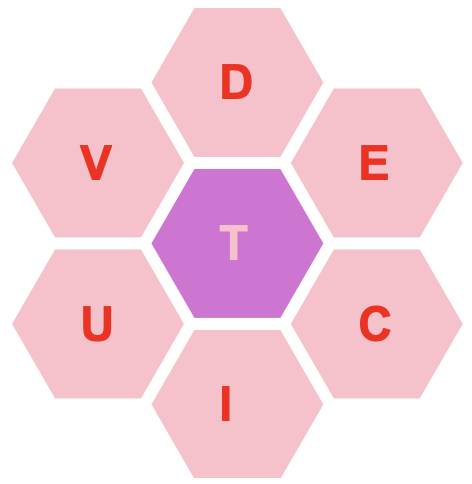

| Command | Name | Center Colors |
|---|---|---|
| CO A | NYT Standard | A |
| CO B | The Blues | B |
| CO C | Floral | C |
| CO D | Dark Mode | D |
| CO E | Black and White | E |
| CO F | Lilac Spring | F |
| CO G | Green Haze | G |
These PreSets are nice but you will very likely want to tweak them in various ways to create your own snazzy color scheme(s). However you set and tweak the colors they will be remembered – they are tied to your ID so they will be preserved from day to day and across browsers.

The CO command by itself will show a table of the current color settings:
| 1 | Center background | CORNFLOWERBLUE |
| 2 | Center text | MIDNIGHTBLUE |
| 3 | Donut background | LAVENDER |
| 4 | Donut text | MEDIUMBLUE |
| 5 | Page background | LIGHTBLUE |
| 6 | Page text | RGB(102,102,102) |
| 7 | Links | CORNFLOWERBLUE |
| 8 | Input background | SKYBLUE |
| 9 | Input text | DARKBLUE |
Colors can be expressed in 4 different ways:
Here’s another command to change the page background (#5) and link (#7) colors:
CO is used to put one of your color schemes in place:
The command LCO will list your color schemes. They can be deleted with XCO:
You can write clues when you create a Community Puzzle as seen below. You can also create clues for NYT Puzzles. To make clues for today’s NYT puzzle there is this link:
When playing an NYT Puzzle, if clues have been provided, there will be a red asterisk * after the date at the top.
Clues are shown when you use the D command. If there are clues from multiple authors they will be color-coded.
The I (information) command will show the names of people who submitted clues. Clicking on an author’s name will show the complete list of their clues. Note that in this display, if you’ve already found a word, that word is appended to the clue and the whole line is in gray rather than black. This helps you focus on the clues for the words you have not yet found. The tradition in the HiveMind Forum is that clues come in the word alphabetical order and can have the length shown as well. If you know this you have more information beyond the clue itself.
The CL command will list the dates of the NYT puzzles for which you have created clues.
If you leave all of the clue fields blank your clue offering is effectively deleted.
There are 5 steps to create a puzzle:
How to find a pangramic word? There are five different ways:
For example, the word “enigma” yields “magazine” from the NYT puzzles, “demanding examining messaging remaining” from the 10,000 word list, and 54 (!) words from the large lexicon - most of which are too esoteric for a “reasonable” puzzle. However 😊 ... among those 54 I do see these that are quite reasonable:
Your name and location.
A title and description for your puzzle (optional).
Is the puzzle is ready
to be “published” and available to the community?
Note that the description is subject to the same formatting as Forum posts. e.g. *hello* becomes hello
A link will be displayed that looks like this:
The LCP command lists the community puzzles.
The RCP command lists puzzles that I recommend because I find them interesting, clever, or an unusual challenge. Puzzles with clues are more likely to be included.
The command YCP will list the community puzzles that you have created. You can click on the CP## link to re-edit your puzzle. You can update/change/delete the words and clues - but not the 7 letters or center letter. You can also change the title and description.
The command XCP<num> can be used to delete puzzles that you have created.
The description of your puzzle can be used to inform people why you made the puzzle and explain any guidelines for what words might be included or excluded.
| MO | Toggle into "mobile mode". Useful when playing on an iPad or Tablet with a touch screen. The 7 letters in the hexagon become tappable. |
| LG | Show a time-stamped log of your activity on the day of the NYT Puzzle. The times are 24 hour format U.S. West Coast Pacific Time |
| LM #mins | Set a limit of how much longer you want to play.
LM 10 will allow you to play for 10 more minutes.
LM without a number will show how much time remains.
When the time has expired this message will be shown:
Your self-imposed time limit has arrived. 😞 This command may prove helpful for those who feel that they are spending too much time on this silly game. |
| PA | Pause your LM time limit. Any action will resume the time. This would be useful if you only want to play for 30 minutes today but would like to do it in three 10 minute sessions throughout the day. |
| AC | Show a stacked bar graph of everyone's activity through the day. Green: #words, Red: #commands, Blue: #dynamic grid queries. The X-axis is hours since midnight, U.S. Pacific Time. The Y-axis is number of commands issued. Monitoring began on December 22, 2022. |
| H | Toggle the presentation
of the 7 letters - either Hexagon or Inline Letters: 
|
| R% | Show the rankings with the percentage of the maximum score. |
| -<word> | Remove the word from the found list. (That’s a dash or hyphen or - or minus sign before the word.) This might be used if you are trying for GOTN: Genius On the Nose. |
| Instead of the full Hint Table | |
| # | How many words remain to be found? |
| #B | How many words beginning with B remain to be found? |
| #4 | How many 4 letter words remain to be found? |
| #>4 | How many words with more than 4 letters remain to be found? This might be useful if you are trying for GN4L: Genius No 4 Letters. |
| Searching the Puzzles | |
| CL | Find puzzles for which you have added clues. |
| F7 | Find puzzles that use the same seven letters as the current puzzle. Also show the percentage of words in the other puzzles that occur in the current puzzle. |
| S <word> | Search for puzzles which include the word. |
| The above 3 commands will search both NYT Puzzles and Community Puzzles. You can click on the date or CP# link to start solving the puzzle. | |
| Fun with the Found Word List | |
| W> | Show the found words in order of increasing length. |
| W>n | Show the found words of length greater than n. |
| W< | Show the found words in order of decreasing length. |
| W<n | Show the found words of length less than n. |
| Wn | Show the found words of length n. |
| W <prefix> | Show the found words that start with <prefix>. |
| W/<pattern> | Show the found words that match the pattern. For example, W/OO will show the found words that contain OO - like OOZE, LOOT, or TATTOO. For Super Power Users: The pattern is a Perl Regular Expression with the /x flag. |
| W!/<pattern> | Show the found words that do NOT match the pattern. This can be used to see the words that do not end in ING or ED by entering this command: W!/(ING|ED)$ |
| 1W | Show the found words in a single column. This may be more convenient if you wish to copy/paste the word list. |
| SL | Show the groups of found words that share the same letters. |
| FT | Show the found words that are appearing for the first time in this puzzle. |
However the Found Word List is shown you can click on each word to get a brief definition of that word. ††† This includes the Donut, Lexicon, Bonus, and Stash words. Click on the brief definition to see the complete definition at wordnik.com in another window.
| |
| FT <word> | Show the date on which the given word appeared for the first time. |
| If you are a minimalist: | |
| HE | Toggle the showing of the header. Default is to show it. |
| WL | Toggle the showing of the list of found words. Default is to show the word lists (Puzzle, Donut, Lexicon, Bonus and Stash). |
| WL <which> | Similar to WL above but you can specify which word lists you want to see: <which> is one or more of P, D, L, B, and S.
Donut Lexicon Bonus Stash All
Note that if you have issued WL PS and then wish to see ALL 5 of the word lists, just issue WLA to see ALL. |
| IM | Toggle the showing of the image for the ranks of Amazing, Genius, and Queen Bee. Default is to show it. |
| Preserving Your Identity | |
| ID | Show the long string of characters that constitute your “identity” to the program. It will look something like this:
963e4401-81eq-18ec-g81c-b1f85c942ex3 This command copies the long string to the system clipboard. Save this string in a secure place. |
| ID ... | In case you inadvertently clear your Website Data (aka cookies) you can restore your identity with this command:
ID 963e4401-81eq-18ec-g81c-b1f85c942ex3 The long string of characters was retrieved from where you securely stored it.
This command also allows you to replicate your identity from one browser to another (e.g. Safari to Chrome or desktop browser to mobile browser).
The long string is computer generated and is guaranteed to be unique - but it is long! A much easier way to establish your identity is to create a string that you know is (very likely) unique to you - like your name plus your birthdate. For example:
|
| Finally, we have the Ultimate Hint: | |
| G Y | Give up and show the words you have not yet found. G Y means Give up and confirm Yes. This just shows the words not yet found. If you wish to actually have them entered append a P to the Y: G YP. That is P for paste or GYP for cheat or swindle. 😬 |
Getting to Genius, Part 1: Spelling Bee for Beginners
Getting to Genius, Part 2
How the Hivemind Conquers Spelling Bee
An Insomniac Plays Spelling Bee
Flight of the Spelling Bee Player
Insider Secrets of the Spelling Bee - An interview with Sam Ezersky
YouTube - Deb Amlen, Sam Ezersky, and William Jackson Harper play the Spelling Bee
These Spelling Bee Hint Writers Want to Help You Get to Genius
Kitt Richards was interviewed for this article. Kitt uses this software to help format her clues.
Contra Bee A love note to spelling bee. This site takes the daily NYT Bee and asks you to enter Donut words. It has an “official” list of Donut words and you try to get to Genius rank by finding all the words in the list. You can play yesterday’s puzzle as well.
bee.ignoble.dev {} Bee - Generates a daily puzzle (not NYT) from the English Aspell Dictionary. There are puzzles going back to 5/17/2020. Puzzles on Sunday have fewer than 41 words. The number of words increases through the week until Friday puzzles have more than 120 words. Saturday puzzles have more than 120 words excluding the letters s and d. Can sort the found words in 3 ways. It has a “spoiler” mechanism to reveal all words. I found a bug in the scoring: Some 4 letter words score more than 4!?? It keeps a tally of how many words of each length you need and have found.
swilliams.io.fun/hex - A Javascript implementation. Fast. Clean code. Uses a file of 1,500 pangramic words and a file of 10,000 common words. A different puzzle each day. No ranks. No hint table. Not NYT Puzzles so not “curated”. Github repo is here.
freebee.fun is a free web version of the game that you can play! Javascript and HTML/CSS. It doesn’t use NYT words so the word list is not “curated”. There is no hint table. Source code in C is available for a command line version.
Philip Shemella A command line game you can play written in Python. Again, doesn't use NYT words. It also generates new games.
Cloning the NYT Bee Written in node.js and other modern tools. Only two games to play. No hint table. Choose “live demo” at the bottom.
bumblewords.com A Javascript game. Clean. Not NYT Puzzles. Cannot type - must click/tap. It has a leaderboard.
A sequence of 7 videos The functionality of the NYT Spelling Bee is (sort of) replicated in Javascript/HTML/CSS. The entire process is explained in great (excruciating) detail.
worker-bee.io No longer active. This was a dynamic Hint Table in Javascript - pretty but somewhat fragile as it didn’t have the full word list.
beesquared.ga Yet another dynamic Hint Table in Javascript similar to worker-bee.io.
Spelling Bee Tips Clues and definitions and incremental revealing. Can paste words from NYT puzzle. Pretty fancy but awkward to use. Where do the clues and definitions come from?
Honeycomb Hints An iOS app. You upload a screenshot of your found words and the app extracts them and updates the Hint Table. How are the words deduced from the image? OCR? Impressive - but troublesome to use. It doesn't verify the words are in the "allowed list" or are even qualified.
Spelling Bee Assistant An extension for the Chrome browser that interacts with the NY Times Spelling Bee site. Provides dynamic counts. No hints or definitions.
Excel Spreadsheet for the Hints Table This updates the hint table as words are found and pasted in.
Spelling Bee Hint Worksheet A kind of spreadsheet you print out and, with a pen or pencil, fill in the words you have found. This is further proof that there is an unmet need for the grid to be dynamic.
Bryn Mawr College An ambitious Senior Project for 4 students.
Finding a Max Score Another video analyzing NYT Bee type puzzles in excruciating detail.
NYT Spelling Bee 2021 in Review Analysis of all 2021 puzzles. By Charlie DiGiovanna & Lea Bourdages.
I do have a subscription to the Times. It is a reliable, trusted, and curated source of information in these troubled times. Subscriptions help the many journalists stay focused on their story.
When the puzzle page is loaded into the web browser the list of allowed words is visible – if you know where to look. This is what you will see in the HTML/Javascript page source:
window.gameData = {
"today": {
"expiration": 1638345600,
"displayWeekday": "Tuesday",
"displayDate": "November 30, 2021",
"printDate": "2021/11/30",
"centerLetter": "h",
"outerLetters": ["d", "g", "i", "n", "o", "t"],
"validLetters": ["h", "d", "g", "i", "n", "o", "t"],
"pangrams": ["goodnight", "hotdogging"],
"answers": ["goodnight", "hotdogging", "dhoti", "doth",
"godhood", "goth", "hiding", "high", "hind",
"hinging", "hint", "hinting", "hitting", "hogging",
"honing", "hood", "hooding", "hoodoo", "hoot",
"hooting", "hotdog", "nigh", "night", "ninth",
"nothing", "thigh", "thin", "thing", "thinning",
"thong", "tight", "tithing", "tonight", "tooth"],
...
So the words in the puzzle are available publicly each day.
The new mechanism I created is simply an alternate way
of using these words.
| ADFLMPU | 06/26/18 | 10/28/19 | 03/07/20 | 06/06/20 | 07/02/20 |
| BILMOTY | 07/20/18 | 10/27/19 | 06/04/20 | 12/01/20 | 07/09/21 |
| GNORTUW | 08/17/18 | 05/02/19 | 12/16/19 | 03/20/20 | 02/04/21 |
| # 7 letter sets |
# of dates |
|---|---|
| 3 | 5 |
| 35 | 4 |
| 97 | 3 |
| 184 | 2 |
The F7 command finds other dates that use the same 7 letters as in the current puzzle. These other puzzles usually (but not always) have a different center letter. Note these identical puzzles: 08/03/19 and 08/24/20.
F7 will also show what percentage of words in the other puzzles are the same as in the current puzzle.
I’m curious why the NY Times has to keep RE-using / recycling the same pangramic words. There are SO many other choices. If you feel the same you can create your own puzzle with a different colorful intriguing pangram! It could even include an S (OMG!) or have both an E and an R! Post a message in the Forum to share your puzzle!
Which puzzles from the large archive to play? You can get one at random with the NR command or you could choose one with various attributes like ones with the most points or the fewest 4 letter words.
Starting an archival puzzle is simple. Just enter the puzzle date (like 12/16/21) in the text field where you would enter a word.
To facilitate your curiousity and research you can see this text file of the many puzzles. The lines have this format:
yyyymmdd => seven center pangrams ... | words ...For example:
20180524 => abceklm k camelback clambake | aback alack ... meekTallies are made of the many puzzles and words. See this table of the puzzles:
You will see date, center letter, # words, # pangrams, score, # four letter words, and bingo. You can sort the table ascending or descending on all these things.
And see this table of the words:
You will see word, length, frequency, and date the word first appeared. You can sort the table ascending or descending on all these things.
If you scroll down on these pages you will see a link to Load the entire file. This was done to make for faster loading of the top of the file (which is likely what you are most interested in).
Another way to do Bee “research” is to search NYT Bee words and large lexicon words for a pattern with this site:
Most people play by trying to find all the words in the puzzle’s “allowed list” ALL BY THEMSELVES – using no other source than their own mind and memory. This is admirable. But we are not all so dedicated or pure nor do we have the time it takes! This is what the hints and clues and definitions are for – to give us a bit of help. You are charged for this assistance by the accumulation of “hint points”. With this help we can get to Genius or Queen Bee. This kind of help is not really cheating.
Another minor cheat is to ask Google how to spell a word. Google is very good at taking a misspelling and showing how it should be spelled. You came up with the word! You simply weren't sure how to spell it!
It you DO want to cheat using more sneaky means there are many ways:
% egrep '^[abcdefg]{4,}$' /usr/share/dict/words | grep g
abcdefg above should be replaced by the seven letters in the
puzzle. Note that g is the center letter.
The above command will show all qualifying puzzle words that occur in the large lexicon. Not all will be in the allowed list as there are many rare and obscure words in that lexicon.
Here is one way to cheat with Donut words (in the OSX Terminal with regular expressions):
% egrep '^[abcdef]{4,}$' /usr/share/dict/words
where abcdef are the 6 donut letters.
Here is one way to cheat with Bonus words (in the OSX Terminal with regular expressions):
% egrep '^[abcdefgj]{6,}$' /usr/share/dict/words | grep j
The above will find Bonus words with an additional letter J.
All browsers have a way to clear the history without removing the website data. For example, on Safari holding the Option (aka Alt) key while clearing the history will Keep Website Data. If you inadvertently clear your cookie (i.e. your identity) with your name and location and I can help restore the cookie.
Note that the ID Power User command is a way to restore your identity yourself.
††
How many different Color Schemes are there?
A bit is either 0 or 1 = 2 states.
A byte has 8 bits giving 28 = 256 values from 0 to 255.
A color is composed of 3 bytes (red, green, blue) so there are 2563 = 16,777,216 unique colors.
A color scheme has a color for each of 9 areas so there are 16,777,2169 >= 1065 different color schemes.
Summarizing:
For even more fun, using dc, the arbitrary-precision arithmetic calculator, the actual answer is:
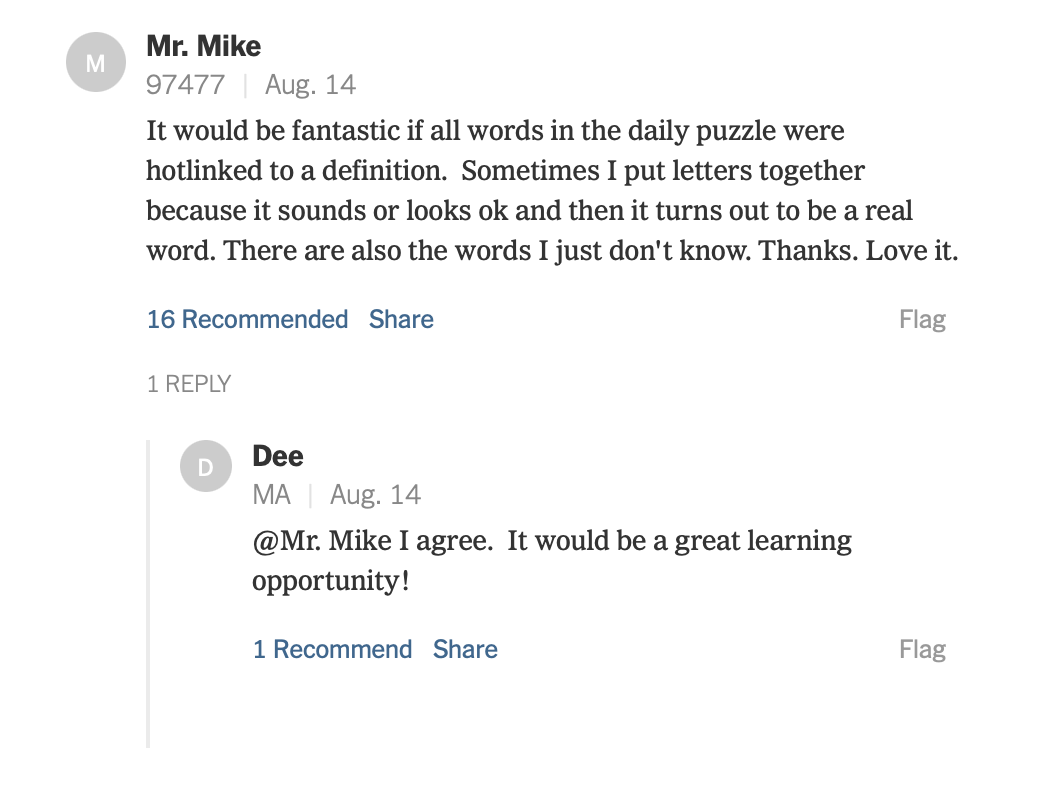
††††
The file /usr/share/dict/words on OSX is known as “the large lexicon”.
This collection of words contains 235,886 words of which 98,634 of them have a
length >= 4 and contain no more than 7 unique letters.
Surprisingly, it is missing many words - such as INTERNET! 😜